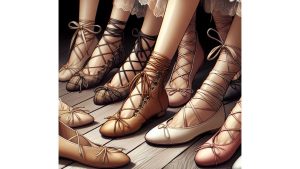Table of Contents
ToggleHow to Properly Tie Your Ankle-Tie Ballet Flats for Comfort and Support

1. Start with a Loose Tie
Begin by loosely wrapping the shoestring around your ankle. Leave enough slack to comfortably move your foot and slide a finger underneath the lace without difficulty.
2. The Comfort Test
After the initial tie, take a few steps around. If you feel any discomfort or pressure points, it might be too tight. Your feet should feel free, without any pinching or rubbing.
3. Snug, Not Strangling
Now, gently tighten the shoestring, but don’t go overboard. Aim for a snug fit that feels secure without constricting your ankle. You want the shoe to move with your foot but not cause any pain.
4. Check for Adjustments
Walk around again and pay attention to any slippage or instability. If your shoe feels loose or wobbly, it might need a slight readjustment. Experiment by slightly tightening or loosening the lace until you find the right balance.
5. Secure the Knot
Once you’ve found the ideal tension, secure the knot firmly, ensuring it won’t come undone while you’re on the go.
Why It Matters
Finding the perfect tension isn’t just about comfort it’s about support too. A well-tied ankle-tie ballet flat can offer better stability, preventing potential slips and enhancing your overall comfort while flaunting your stylish footwear.
Remember, comfort is key. A properly tied shoestring should allow you to move freely without causing any discomfort or leaving marks on your skin. Play around with the tension until it feels just right for you. Happy strutting.
Maintaining the Perfect Fit
Now that you’ve nailed the ideal tension for your ankle-tie ballet flats, maintaining that perfect fit is key for long-lasting comfort and style. Here are some tips to keep your shoestring secure and your feet happy:
1. Regular Checks
Give your shoestrings a quick once-over before heading out. Ensure they’re still comfortably snug but not overly tight. Adjust as needed for any changes in your feet or the shoes themselves.
2. Re-Tying When Needed
Throughout the day, if you feel your shoes loosening or notice any discomfort, don’t hesitate to re-tie them. It’s okay to readjust the tension to keep your feet feeling great.
3. Avoid Over-Tightening
While a snug fit is important, avoid the temptation to over-tighten the shoestring. It might seem like it provides extra stability, but it could lead to discomfort and even restrict proper blood flow to your feet.
4. Shoestring Care
Keep an eye on the condition of your shoestring. Replace it if it starts to fray or shows signs of wear and tear. A fresh, sturdy lace ensures both style and functionality.
5. Listen to Your Feet
Your feet are your best advisors. If they start to feel uncomfortable or you notice any redness or irritation around the ankle, it’s a sign that the shoestring might be too tight. Loosen it up a bit to prevent discomfort.
The Verdict
Properly tying your ankle-tie ballet flats not only enhances your style game but also ensures your feet are well-supported throughout the day. Strike that balance between snugness and comfort, and remember, it’s okay to readjust as needed to keep your feet happy and healthy.
By following these simple steps, you’ll rock your ankle-tie ballet flats with confidence, comfort, and style!
Comparison tabular
Here’s a simple comparison table summarizing the key points:
| Aspect | Too Loose | Just Right | Too Tight |
|---|---|---|---|
| Initial Tie | Allows excessive movement | Fits comfortably with finger space | Feels constricting |
| Comfort Test | Feet feel unstable, potential slips | Comfortable, free movement | Causes discomfort, pressure points |
| Tension Level | Excessive slack, shoe wobbling | Snug but not tight | Painful, cuts off circulation |
| Adjustments Needed | Loose, risk of slipping | Minimal, for slight readjustment | Causes discomfort or marks |
| Overall Impact | Lack of support, potential blisters | Comfort and stability | Discomfort, potential injury |
This table should help you visualize the differences between too loose, just right, and too tight tensions when tying your ankle-tie ballet flats. Remember, finding the perfect balance ensures both comfort and style.
Wrapping up
In conclusion, the ideal tension for tying your ankle-tie ballet flats lies in the balance between comfort and support. Finding that sweet spot neither too loose nor too tight is crucial for a pleasant walking experience.
By following the steps outlined and paying attention to how your feet feel, you can achieve the perfect tension. Remember, your comfort matters most! Keep your shoestrings in check, make adjustments as needed, and prioritize the health and well-being of your feet.
Now that you’ve mastered the art of tying your ankle-tie ballet flats, step out confidently, flaunt your style, and enjoy every stride with ease and comfort. Cheers to comfortable and stylish footwear that keeps you on your toes all day long.

Mike the founder of The Shoe String Forum.com, has always had a lifelong love for shoes since he was a kid and with a fervent love for diverse brands like Adidas, Puma, Louis Vuitton, Nike, Birkenstocks, Hey Dudes, Crocs, Vans, Uggs, Converse, and New Balance, he passionately shares extensive footwear research through this platform.
Related Posts
- Are all shoestring holes On your Ankle-tie ballet flats functional the same
Ankle-tie ballet flats are a versatile and stylish choice for footwear, offering both comfort and…
- How tight should you normally shoestring the Pointed-toe ballet flats?
When it comes to your pointed-toe ballet flats, nailing the shoestring tightness is key for…
- Are all shoestring holes On Classic ballet flats functional the same?
If you've ever owned a pair of classic ballet flats, you might have noticed those…
